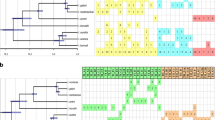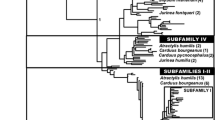Abstract
Satellite DNAs are known for an unusual and nonuniform evolution characterized by rapid evolutionary change between species and concerted evolution leading to molecular homogeneity within species. In this paper we use satellite DNAs for phylogenetic analysis of a rapidly evolving lineage of spiders and compare the phylogeny with a hypothesis previously generated based on mitochondrial DNA and allozymes. The spiders examined include almost all species within a monophyletic clade of endemic Hawaiian Tetragnatha species, the spiny-leg clade. The phylogeny based on satellite sequences is largely congruent to those produced by mtDNA and allozymes, except that the satellite DNA yields much longer branches, with higher levels of support for any given node. Closely related species that have differentiated ecologically within an island are well resolved with satellite DNA but much less so with mtDNA. These results suggest that Tetragnatha stDNA repeats seem to be evolving gradually and cohesively during the diversification of these endemic Hawaiian spiders. The study also reveals gain–loss of satellite DNA copies during species diversification. We conclude that satellite DNA sequences may potentially be very useful for resolving relationships between rapidly evolving taxa within an adaptive radiation. In addition, satellite DNA as a nuclear marker suggests that hybridization or peripatry could play a possible role in species formation that cannot be revealed by mitochondrial markers due to its maternal inheritance.





Similar content being viewed by others
References
I A’lvarez JF Wendel (2003) ArticleTitleRibosomal ITS sequences and plant phylogenetic inference Mol Phylogenet Evol 29 417–434
U Arnason S Gretarsdottir B Widegren (1992) ArticleTitleMysticetae (baleen whale) relationships based upon the sequence of the common cetacean DNA satellite Mol Biol Evol 9 1018–1028
L Bachmann D Sperlich (1993) ArticleTitleGradual evolution of a specific satellite DNA family in Drosophila ambigua, D. tristis, and D. obscura Mol Biol Evol 10 647–659
DL Brutlag (1980) ArticleTitleMolecular arrangement and evolution of heterochromatin DNA Annu Rev Genet 14 121–144
HL Carson DA Clague (1995) Geology and biogeography of the Hawaiian Islands WL Wagner V Funk (Eds) Hawaiian biogeography: Evolution on a hot spot archipelago Smithsonian Institution Press Washington, DC 14–29
R la Herran Particlede CR Rejon MR Rejon MA Garrido-Ramos (2001) ArticleTitleThe molecular phylogeny of the Sparidae (Pisces, Perciformes) based on two satellite DNA families Heredity 87 691–697
GA Dover (2002) ArticleTitleMolecular drive Trends Genet 18 587–589
JF Elder BJ Turner (1995) ArticleTitleConcerted evolution of repetitive DNA sequences in eukaryotes Q Rev Biol 70 297–323 Occurrence Handle10.1086/419073 Occurrence Handle1:CAS:528:DyaK2sXksFGrurY%3D Occurrence Handle7568673
RG Gillespie (1991) ArticleTitleHawaiian spiders of the genus Tetragnatha. I. Spiny leg clade J Arachnol 19 174–209
RG Gillespie (1999) ArticleTitleComparison of rates of speciation in web-building and non-web-building groups within a Hawaiian spider radiation J Arachnol 27 79–85
RG Gillespie (2002) ArticleTitleHawaiian spiders of the genus Tetragnatha. IV: New, small species in the spiny leg clade J Arachnol 30 159–172
R Gillespie (2004) ArticleTitleCommunity assembly through adaptive radiation in Hawaiian spiders Science 303 356–359
RG Gillespie SR Palumbi HB Groom (1994) ArticleTitleMultiple origins of a spider radiation in Hawaii Proc Natl Acad Sci USA 91 2290–2294
RG Gillespie HB Croom GL Hasty (1997) ArticleTitlePhylogenetic relationships and adaptive shifts among major clades of Tetragnatha spiders (Araneae: Tetragnathidae) in Hawai’i Pacif Sci 51 380–394
DS Gladstein WC Wheeler (1997) POY: The optimization of alignment characters American Museum of Natural History New York
DM Hillis C Moritz CA Porter RJ Baker (1991) ArticleTitleEvidence for biased gene conversion in concerted evolution of ribosomal DNA Science 251 308–310
G Hormiga MA Arnedo RG Gillespie (2003) ArticleTitleSpeciation on a conveyor belt: sequential colonization of the Hawaiian Islands by Orsonwelles spiders (Araneae: Linyphiidae) Syst Biol 52 70–88
JP Huelsenbeck F Ronquist (2001) ArticleTitleMRBAYES: Bayesian inference of phylogenetic trees Bioinformatics 17 754–755 Occurrence Handle10.1093/bioinformatics/17.8.754 Occurrence Handle1:STN:280:DC%2BD3MvotV2isw%3D%3D Occurrence Handle11524383
S Jordan C Simon D Polhemus (2003) ArticleTitleMolecular systematics and adaptive radiation of Hawaii’s endemic damselfly genus Megalagrion (Odonata: Coenagrionidae) Syst Biol 52 89–109
R Kalendar J Tanskanen S Immonen E Nevo AH Schulman (2000) ArticleTitleGenome evolution of wild barley (Hordeum spontaneum) by BARE-1 retrotransposon dynamics in response to sharp microclimatic divergence Proc Natl Acad Sci USA 97 6603–6607 Occurrence Handle10.1073/pnas.110587497 Occurrence Handle1:CAS:528:DC%2BD3cXktFaju7Y%3D Occurrence Handle10823912
N Mestrovic M Plohl B Mravinac D Ugarkovic (1998) ArticleTitleEvolution of satellite DNAs from the genus Palorus—Experimental evidence for the “library” hypothesis Mol Biol Evol 15 1062–1068
GL Miklos AC Gill (1981) ArticleTitleThe DNA sequences of cloned complex satellite DNAs from Hawaiian Drosophila and their bearing on satellite DNA sequence conservation Chromosoma 82 409–427
T Ohta GA Dover (1984) ArticleTitleThe cohesive population genetics of molecular drive Genetics 108 501–521
F Panzera R Perez Y Panzera F A’lvarez E Scvortzoff R Salvatella (1995) ArticleTitleKaryotype evolution in holocentric chromosomes of three related species of triatomines (Hemiptera–Reduviidae) Chromosome Res 3 143–150
J Pons RG Gillespie (2003) ArticleTitleCommon origin of the satellite DNAs of Hawaiian spiders of the genus Tetragnatha: Evolutionary constraints on the length and nucleotide composition of the repeats Gene 313 169–177
J Pons E Petitpierre C Juan (2002) ArticleTitleEvolutionary dynamics of satellite DNA family PIM357 in species of the genus Pimelia (Tenebrionidae, Coleoptera) Mol Biol Evol 19 1329–1340
J Pons B Bruvo E Petitpierre M Plohl D Ugarkovic C Juan (2004) ArticleTitleComplex structural features of satellite DNA sequences in the genus Pimelia (Coleoptera: Tenebrionidae): Random differential amplification from a common satellite DNA library Heredity 92 418–427
D Posada KA Crandall (1998) ArticleTitleModeltest: testing the model of DNA substitution Bioinformatics 14 817–818 Occurrence Handle10.1093/bioinformatics/14.9.817 Occurrence Handle1:CAS:528:DyaK1MXktlCltw%3D%3D Occurrence Handle9918953
J Rozas R Rozas (1997) ArticleTitleDnaSP version 2.0, a novel software package for extensive molecular population genetic analysis Comput Applic Biosci 13 307–311
T Strachan D Webb GA Dover (1985) ArticleTitleTransition stages of molecular drive in multiple-copy DNA families in Drosophila EMBO J 4 1701–1708
DL Swofford (2002) PAUP*. Phylogenetic Analysis Using Parsimony (*and other methods) Sinauer Associates Sunderland, MA
M Trick GA Dover (1984) ArticleTitleUnexpectedly slow homogenization within a repetitive DNA family shared between two subspecies of tsetse fly J Mol Evol 20 322–329
D Ugarkovic M Plohl (2002) ArticleTitleVariation in satellite DNA profiles—causes and effects EMBO J 21 5955–5959 Occurrence Handle10.1093/emboj/cdf612 Occurrence Handle1:CAS:528:DC%2BD38XptFOrt7w%3D Occurrence Handle12426367
WL Wagner V Funk (1995) Hawaiian biogeography: Evolution on a hot spot archipelago Smithsonian Institution Press Washington, DC
WC Wheeler (1996) ArticleTitleOptimization alignment: The end of multiple sequence alignment in phylogenetics? Cladistics 12 1–9
WC Wheeler (2002) Optimization alignment: down, up, error, and improvements R DeSalle G Giribet WC Wheeler (Eds) Techniques in molecular systematics and evolution Birkhäuser Basel 55–69
WC Wheeler (2003) ArticleTitleImplied alignment: A synapomorphy-based multiple-sequence alignment method and its use in cladogram search Cladistics 19 261–268
Acknowledgments
This work was funded by a grant from the Obra Cultural i Social Sa Nostra Fundation (Spain) to J.P., with additional funds from the Schlinger Foundation, and a National Science Foundation (DEB 9726573) grant to R.G.G. For help with fieldwork, we are indebted to Haleakala National Park, the Nature Conservancy of Hawaii, Maui Pineapple Company, the State Department of Land and Natural Resources, and the Hawaii Natural Areas Reserve System. For help with collecting we owe particular thanks to M.A. Arnedo, R. Bartlett, C.F. Davenport, J. Giffin, A.C. Medeiros, D. Preston, and G.K. Roderick. We also thank M.A. Arnedo for help with the POY analysis.
Author information
Authors and Affiliations
Corresponding author
Additional information
Reviewing Editor: Dr. Rafael Zardoya
Appendix
Rights and permissions
About this article
Cite this article
Pons, J., Gillespie, R.G. Evolution of Satellite DNAs in a Radiation of Endemic Hawaiian Spiders: Does Concerted Evolution of Highly Repetitive Sequences Reflect Evolutionary History?. J Mol Evol 59, 632–641 (2004). https://doi.org/10.1007/s00239-004-2655-2
Received:
Accepted:
Issue Date:
DOI: https://doi.org/10.1007/s00239-004-2655-2




